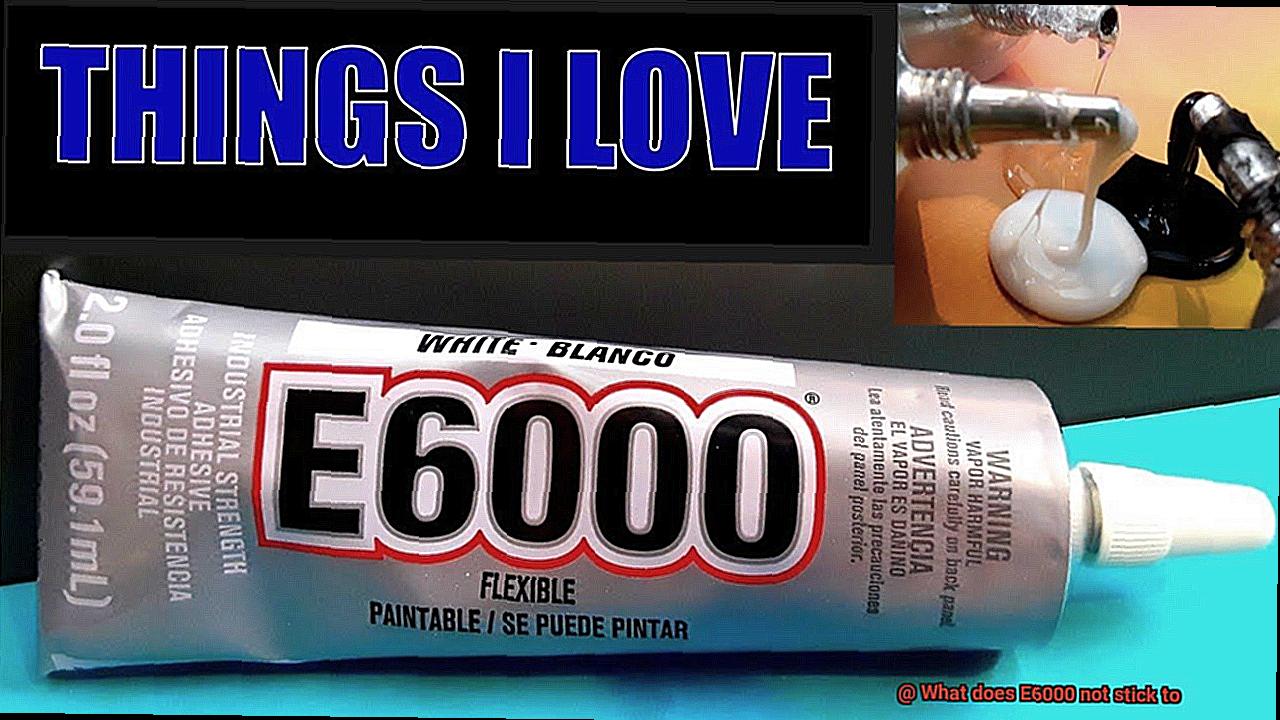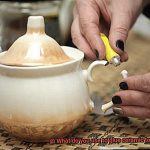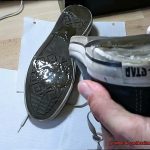When it comes to DIY projects or repairs, finding the perfect adhesive is key. Enter E6000, the holy grail of versatility and strong bonding capabilities. Crafters, hobbyists, and professionals alike swear by this adhesive for its ability to stick to almost anything. But hold your glue guns, folks. Before you dive headfirst into your next project, it’s crucial to know where E6000 falls short.
In this blog post, we’re going to dig deep into the topic of what E6000 does not stick to. Why? Because understanding these limitations can save you from potential mishaps or disappointments in your crafting journey. Whether you’re a seasoned pro or a newbie with shaky hands, this guide will equip you with all the knowledge you need to make informed decisions about which materials play well with E6000.
From dainty fabrics that need extra TLC to certain plastic surfaces that give E6000 a run for its money, there are boundaries even this mighty adhesive must respect. By exploring these limitations together, we’ll ensure frustration-free bonding and successful DIY ventures every time.
So, grab your safety goggles and let’s dive into the fascinating world of E6000 to uncover which surfaces it just can’t quite stick to effectively.
What is E6000?
Contents
E6000 is a versatile and high-performance adhesive that is widely used in crafting, DIY projects, and professional applications. It is known for its strong bonding capabilities and can adhere to a variety of materials, including metals, glass, ceramics, wood, fabric, leather, and many plastics.
The adhesive is resistant to water, chemicals, and extreme temperatures, making it suitable for both indoor and outdoor use. This means you can trust E6000 to hold up even in harsh weather conditions or when exposed to harsh chemicals.
E6000 is available in various forms, including tubes, syringes, and squeeze bottles. It has a thick consistency that allows for easy application without dripping or running. This means you can apply the adhesive exactly where you need it without worrying about messy drips or uneven coverage.
When using E6000, it is important to apply it in a well-ventilated area. The adhesive has a strong odor that can be overpowering in enclosed spaces. Additionally, it is recommended to wear gloves to protect your skin from direct contact with the adhesive. Safety should always be a priority when working with any adhesive.
While E6000 is highly effective at bonding to a wide range of materials, there are certain surfaces that it may not stick to as well. These include polyethylene, silicone, certain types of rubber with high silicone content, Styrofoam or other foam materials, and surfaces that come into direct contact with food or beverages. It is important to note these limitations to ensure you choose the right adhesive for your specific project.
What Surfaces Does E6000 Not Stick To?
E6000, a popular adhesive known for its versatility and strong bonding capabilities, does have a few limitations when it comes to certain surfaces. Understanding these limitations can help users determine when it is appropriate to use E6000 and when alternative options may be necessary.
One of the surfaces that E6000 may struggle to adhere to is silicone. Silicone is a rubber-like material that is resistant to many types of adhesives. While E6000 may initially bond to silicone, over time, the bond can weaken and fail. So it’s better to avoid using E6000 on silicone surfaces if you want a long-lasting bond.
Similarly, E6000 may not stick well to polyethylene and polypropylene plastics. These plastics have low surface energy, making it difficult for adhesives to form strong bonds. If you need to bond polyethylene or polypropylene, it is best to choose an adhesive specifically designed for these materials.
Another surface that E6000 may not adhere to effectively is Teflon. Teflon is a nonstick material commonly used in cookware and other applications where low friction is desired. The nonstick properties of Teflon make it challenging for adhesives like E6000 to form a secure bond. It’s recommended to explore alternative adhesives when working with Teflon surfaces.
E6000 may also struggle to stick to certain types of metals that have high levels of oil or grease on their surfaces. Before applying E6000 to metal surfaces, it’s important to ensure that the area is clean and free from any contaminants that could interfere with the adhesive’s bonding ability.
Additionally, E6000 may not be suitable for bonding certain fabrics or materials with high levels of flexibility or stretchiness. The adhesive may not provide the necessary flexibility and durability required for these applications. It’s advisable to test the adhesive on a small, inconspicuous area of the fabric or material before committing to a larger project.
Polyethylene
Polyethylene is a versatile and widely used thermoplastic polymer that has numerous applications in various industries. It is known for its low cost, durability, and chemical resistance, making it a preferred choice for packaging, containers, pipes, and toys.
However, when it comes to adhesive bonding, polyethylene presents a challenge. This is due to its unique molecular structure and surface properties. Polyethylene consists of long chains of carbon atoms with hydrogen atoms bonded to them. These chains are highly non-reactive and have a low surface energy, which means they do not readily form bonds with other substances.
In addition to its low surface energy, polyethylene also has a smooth and slippery surface. This lack of surface irregularities or roughness reduces the contact area between the adhesive and the polyethylene surface, making it harder for the adhesive to adhere effectively.
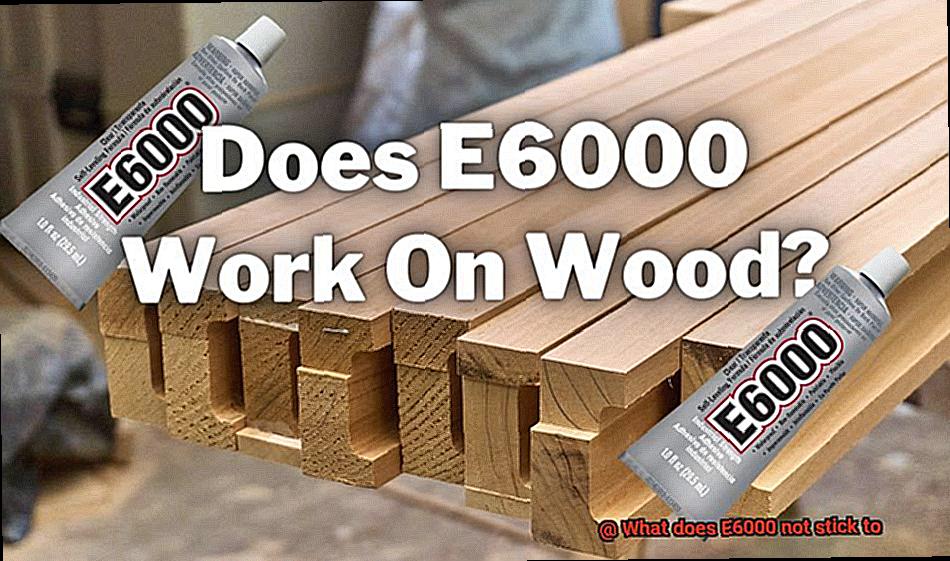
To overcome these challenges and improve the adhesion of adhesives like E6000 to polyethylene, several strategies can be employed. One common approach is surface treatment. By treating the polyethylene surface prior to applying the adhesive, its surface energy can be increased, allowing for better wetting and bonding. Flame treatment or corona discharge treatment are commonly used methods to modify the surface properties of polyethylene and enhance its adhesion to adhesives.
Another option is to use a primer specifically designed for polyethylene bonding. Primers contain adhesion promoters or surface modifiers that create a compatible surface for the adhesive to bond with. These primers can significantly improve the bonding performance of adhesives on polyethylene.
However, it is important to note that while these methods can enhance the adhesion of adhesives to polyethylene, they may not guarantee a permanent and strong bond. The success of the bonding process also depends on factors such as the specific grade of polyethylene, surface cleanliness, and application technique.
Silicone
Silicone is a remarkable material that finds its use in various applications, ranging from sealants and adhesives to everyday kitchenware and advanced medical devices. Its versatility and unique properties make it a popular choice in many industries. However, when it comes to bonding pure silicone surfaces with an adhesive like E6000, there are several challenges that need to be addressed.
One of the main challenges is silicone’s low surface energy. This means that silicone has a weak attraction to other materials, making it difficult for adhesives to form a strong bond. The low surface energy prevents the adhesive from spreading evenly across the surface and achieving good wetting, resulting in a weaker bond.
Another challenge is silicone’s lack of chemical reactivity. Silicone is chemically inert, meaning it does not readily react with other substances. This poses a challenge for adhesives trying to create strong chemical bonds with silicone surfaces.
Temperature resistance is another consideration when selecting an adhesive for silicone bonding. Silicone is known for its high temperature resistance, which can make it challenging to find an adhesive that can withstand these conditions. While E6000 is a general-purpose adhesive, its temperature resistance may not be sufficient for bonding silicone surfaces exposed to high temperatures.
In addition to these challenges, the flexibility of silicone can also pose difficulties for adhesives. Silicone is a flexible material that can undergo significant deformation without losing its shape or properties. This flexibility can make it challenging for adhesives to maintain a strong bond over time, especially if the bonded components are subject to frequent movement or stress.
To overcome these challenges, there are some potential solutions available. Properly preparing the silicone surface is crucial for improving bond strength. This includes thorough cleaning of the surface to remove any dirt, dust, or oils that may hinder adhesion. Additionally, using an appropriate primer specifically designed for bonding silicone can significantly enhance the adhesion properties.
Specialized silicone adhesives are also available on the market. These adhesives are formulated to overcome the challenges associated with silicone’s low surface energy and lack of reactivity. They often have enhanced wetting properties and can provide a stronger and more durable bond.
In some cases, using mechanical fasteners such as screws or clips alongside adhesive bonding can help improve the overall strength of the bond. This approach takes advantage of silicone’s flexibility while providing additional support and stability.
Rubber
Rubber is a remarkable material that offers elasticity, durability, and resistance to heat and chemicals. It can be found in various forms, including natural rubber, synthetic rubber, and different types of elastomers. Used extensively in industries such as automotive, construction, and manufacturing, rubber proves its versatility time and time again. However, when it comes to bonding rubber surfaces, not all adhesives are created equal.
Enter E6000, a popular adhesive known for its strong bonding capabilities. While it excels at bonding many materials, rubber poses a unique challenge. Rubber’s low surface energy means it lacks reactive sites for adhesives to form a robust connection. Unfortunately, this is where E6000 falls short.
The difficulty lies in E6000’s struggle to effectively penetrate the surface of rubber. As a result, adhesion is weakened. To compound matters, rubber surfaces often harbor oils or other substances that act as a barrier between the adhesive and the rubber itself. This less-than-ideal situation makes it challenging to achieve a secure bond.
But fret not. There are strategies to overcome these obstacles. By properly preparing the rubber surface through thorough cleaning and using a primer specifically designed for bonding rubber, the effectiveness of E6000 (or any adhesive of your choice) can be significantly enhanced.
However, if you’re seeking an exceptionally strong bond between rubber and another material, it’s worth exploring specialized adhesives formulated explicitly for bonding rubber. These magical potions possess unique properties that enable them to create stronger bonds with rubber surfaces.
Foam Materials
Foam materials are like the chameleons of the material world – versatile, lightweight, and oh-so-comfortable. But when it comes to sticking them together, things can get a little tricky. These spongy substances have low surface energy and a porous nature that make them challenging to bond. That’s where adhesives like E6000 come in, but even this superhero adhesive has its limits.
Let’s dive into the foamiverse and explore some foam materials that might give E6000 a run for its money:
- Polyethylene Foam: This closed-cell foam is a go-to for cushioning and insulation. Its smooth surface and non-porous nature make it a tough nut to crack for adhesives. While E6000 can give it a good initial stick, it may not last long or hold up reliably.
- Expanded Polystyrene Foam (EPS): Lightweight and used in packaging and insulation, EPS foam is as smooth as a baby’s bottom. But that smoothness, combined with its low surface energy, can make it a real challenge for adhesives like E6000 to create a secure bond. Plus, the solvent-based nature of E6000 can actually damage EPS foam, melting it away like an ice cream cone on a hot summer day.
- Polyurethane Foam: Soft and bouncy, polyurethane foam is the stuff of cushions and upholstery dreams. But its open-cell structure poses a problem for adhesive bonding. It loves to gobble up liquids, making it difficult for E6000 to get a grip. That’s why specialized adhesives formulated specifically for polyurethane foam are the way to go.
- Silicone Foam: When it comes to heat resistance and flexibility, silicone foams take the cake. But their smooth and non-porous surface makes them just as slippery for adhesives like E6000. To keep silicone foam stuck together, it’s best to explore alternative adhesive options designed specifically for silicone-based materials.
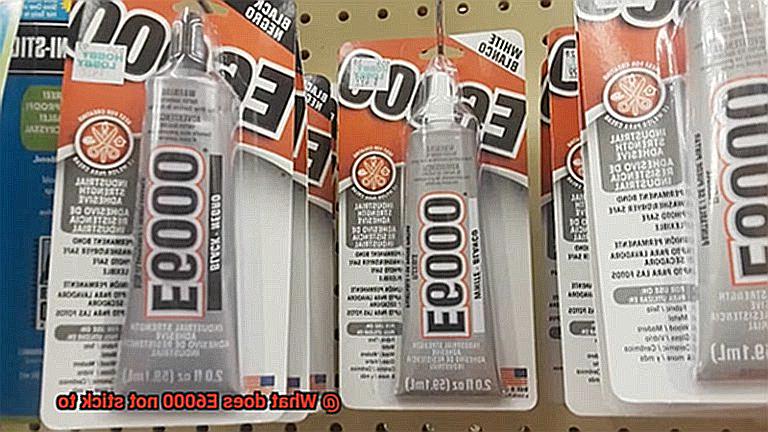
Food and Beverage Contamination
Food and beverage contamination is a pressing concern that poses serious health risks for consumers. Ensuring that adhesives used in food-related applications do not contaminate the food or beverages is of utmost importance. One adhesive that requires extra caution is E6000, a popular adhesive known for its strength and versatility.
E6000 is a powerful adhesive that bonds to various materials such as metals, plastics, glass, ceramics, and fabrics. However, it should never come into direct contact with food or beverages. This is because E6000 contains chemicals that can leach into the food or beverage, posing health risks.
The main concern with using E6000 in food-related applications is the presence of volatile organic compounds (VOCs). VOCs are chemicals that easily vaporize at room temperature and can be inhaled or ingested, causing adverse health effects. E6000 contains VOCs like toluene and xylene, known to cause respiratory irritation, headaches, dizziness, and more severe health issues with prolonged exposure.
In addition to VOCs, E6000 also contains other potentially harmful chemicals like acetone and naphtha. If ingested or absorbed through the skin, these chemicals can have adverse effects on the human body. Thus, it is imperative to keep E6000 away from any food or beverage items to prevent contamination.
To ensure the safety of food and beverages, it is recommended to use adhesives specifically designed for food-related applications. These adhesives are formulated with food-grade ingredients that are safe for direct contact with food and beverages. They are odorless, non-toxic, and resistant to moisture, heat, and common food environment chemicals.
When working on projects involving food or beverage items, it is vital to carefully read and follow the adhesive manufacturer’s instructions. This includes understanding the limitations and recommended uses of the adhesive. If uncertain about the suitability of a particular adhesive for a specific application, consulting the manufacturer or seeking professional advice is advised.
Oily or Greasy Surfaces
Creating a strong bond between adhesive and oily or greasy surfaces requires careful consideration. The presence of oils and greases can hinder the effectiveness of adhesive, forming a barrier that impedes bonding. This section delves into the necessary steps for achieving optimal bond strength when using E6000 adhesive on such surfaces.
Thoroughly clean and degrease the surface:
- Utilize a mild detergent or solvent specifically formulated to eliminate oils and greases.
- Ensure the cleaning agent is compatible with the material to prevent damage.
- Eliminate any loose debris or particles from the surface.
Roughen the surface:
- Employ sandpaper or an abrasive material to gently scuff the surface.
- This action creates microscopic grooves that enhance adhesion by providing additional surface area for bonding.
- Exercise caution during roughening to avoid surface damage.
Apply the adhesive properly:
- Use a clean, dry applicator, such as a brush or nozzle, to apply a thin and even layer of E6000 onto the prepared surface.
- Avoid excessive adhesive application, as excess squeeze-out can weaken the bond.
- Guarantee complete coverage of the entire surface with adhesive.
Allow adequate curing time:
- Comply with the manufacturer’s instructions regarding curing time, which may depend on factors like temperature and humidity.
- Refrain from subjecting bonded materials to stress or load until the adhesive has fully cured.
- Curing time plays a vital role in achieving optimal bonding strength.
Consider alternative adhesives if necessary:
- In cases involving extreme oiliness or greasiness, E6000 might struggle to achieve effective bonding.
- Explore alternative adhesives specifically formulated for bonding to oily or greasy surfaces.
- Prioritize compatibility testing by applying the adhesive to a small, inconspicuous area to ensure desired results.
SBoLZJBGM5o” >
Conclusion
In conclusion, E6000 is a versatile and powerful adhesive that can work wonders in bonding a wide range of materials. However, it does have its limitations. Certain surfaces like silicone, polyethylene and polypropylene plastics, Teflon, and metals coated in oil or grease may pose a challenge for E6000’s sticking power. Additionally, fabrics or materials with high levels of flexibility or stretchiness, as well as foam materials like polyethylene foam, expanded polystyrene foam (EPS), polyurethane foam, and silicone foam may not be the best match for this adhesive.
Furthermore, it’s important to note that E6000 should never come into direct contact with food or beverages. This is due to the presence of volatile organic compounds (VOCs) and other potentially harmful chemicals. So when it comes to projects involving food items or drinks, it’s crucial to opt for adhesives specifically designed for such applications – ones that are safe for direct contact with edibles.
To overcome these challenges and ensure successful bonding with E6000, proper surface preparation is key. Thoroughly cleaning the surfaces and using primers specifically formulated for those materials can greatly enhance the adhesive’s effectiveness. In some cases, you might even need to explore alternative adhesives that are specially formulated for the specific material you’re working with.
By understanding these limitations and taking them into account when choosing an adhesive for your project, you’ll be able to make informed decisions and achieve optimal results.

